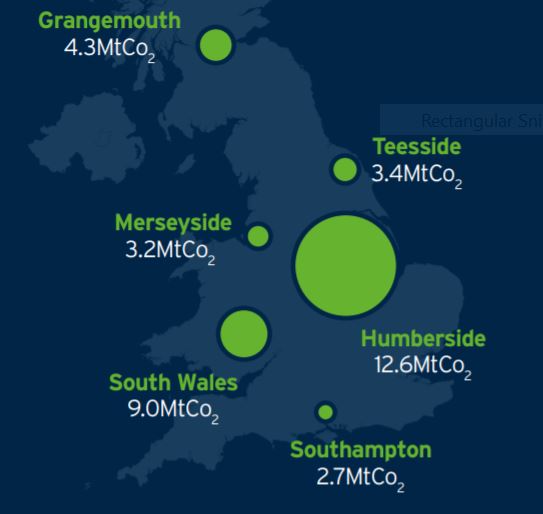Humber LEP launches vision for Clean Growth

Read the full report here: Humber Clean Growth White Paper.
The ambitious plan aims to put the Energy Estuary at the forefront of what LEP Chair Lord Haskins called “the biggest global question today”: addressing climate change while maintaining economic growth.
The Humber Clean Growth Local White Paper confirms the region’s ambition to achieve net zero carbon emissions by 2040, which had been proposed in the consultation the LEP launched at its annual business summit in June. Currently the Humber has the highest carbon emissions of any UK industrial cluster.
To achieve this, commitments include:
- The Humber LEP and industry body CATCH will lead the development of a roadmap for reducing industrial emissions, with an initial funding bid to be submitted to Government next month.
- A group of leading academic and business experts will be recruited to advise on the region’s plans, with a “Net Zero Commission” due to get under way early next year.
- SMEs will be offered additional decarbonisation and energy efficiency support through the LEP’s Business Growth Hub, subject to final funding approval.
- The LEP will work with industry, transport firms and other potential users to develop the demand for hydrogen fuel – with a view to also attracting clean production to the region, adding to the area’s existing chemicals cluster.
- The Humber LEP will work with neighbouring LEPs in North Yorkshire and Lincolnshire to support the area’s large food and agriculture sector to decarbonise.
- The LEP will continue existing work with the offshore wind industry to develop the local supply chain, and with businesses seeking to develop carbon capture and storage in the region.
With the general election campaign getting under way, the White Paper also calls for support from the next government, including:
- Working with the area to explore the financing models and business and community incentives required to support decarbonisation.
- Supporting international marketing of the Humber’s proposition for clean growth in order to attract more new investment to the area.
- Backing the University of Hull-led bid to the Strength in Places Fund as a first step towards increasing local energy innovation capacity.
Further actions will be set out in the Humber Local Industrial Strategy, alongside commitments on key sectors including engineering and assembly, logistics and tech, as well as cross-cutting issues like infrastructure and skills. Accelerated by ministers in the summer, the LEP has been in advanced discussions with Government and local partners over recent months and a final draft has been approved by the LEP Board – but publication will now have to wait until after the election.
Lord Haskins, Chair of the Humber LEP, said: “The biggest global question today is how to address climate change while maintaining economic growth. The Humber is essential to the UK’s transition to a net zero carbon economy.
“Our region is already at the forefront of delivering clean electricity, with the largest offshore wind farm in the world under construction, and in future should be a leader in developing and deploying decarbonisation solutions across industry, transport and homes. By being proactive at a local level we have a chance to protect what we already have, and ensure our businesses and residents can benefit from this transition.
“What has come across clearly from the businesses, local authorities and other organisations involved in this work is the level of ambition from the Humber and the desire to get on with this quickly. There are a lot of exciting projects being developed which would accelerate the progress our region is already making.
“This White Paper and our Local Industrial Strategy give the next Government, whatever the colour, a compelling proposition from the Humber which I hope ministers will get behind straight away after the election.”
As part of putting the White Paper together, the Humber LEP has engaged with businesses across the area, from major employers to SMEs, in a number of different sectors, as well as local authorities and other local institutions.
Energy intensive industries make up almost a quarter of the value of the Humber economy, and account for one in ten jobs in the region. Protecting their long-term competitiveness is a key ambition in the White Paper, and will be supported by the new roadmap for reducing emissions to be developed by the LEP and CATCH.
David Talbot, CEO of CATCH, said: “The industrial emitters across the Humber region are primed and ready to collaborate with key stakeholders to address technology, infrastructure and policy gaps and overcome barriers to review and prioritise different decarbonisation models and 2040 net-zero options for the Humber industrial cluster. CATCH and the Humber LEP will work together to secure funding to develop a roadmap for decarbonising the Humber industrial cluster.”
Humber local authorities have been closely involved in developing the Local Industrial Strategy.
Councillor Stephen Brady, Leader of Hull City Council, said: “We are proud to support the Humber Local Industrial Strategy.
“This region faces a growing threat from climate change, with the second-highest threat of flood risk in the country. We also have a large cluster of energy-intensive industries that are vital to the UK economy, which we are working with to transition to a low-carbon future.
“In Hull, we have identified climate change as a key challenge and have set ambitious targets through the declaration of a climate emergency in March this year and a commitment to become carbon-neutral by 2030.
“The Living with Water Partnership focused around flooding and water shortage and the growth of offshore wind power and Siemens Gamesa blade factory show we are already meeting the challenge to create a low-carbon future in the city.
“Decarbonisation provides a big economic opportunity for the region as lower-carbon sectors are growing at a faster rate than other areas. This is good news for the Humber as the UK’s Energy Estuary and a key piece of the UK’s world-leading offshore wind sector.”
Cllr Philip Jackson, leader of North East Lincolnshire Council, said: “Over the last few years, we’ve been working hard with our neighbouring authorities to build on our collective growing reputation, leading the way in the clean energy revolution and powering the UK. Our offshore wind operations and maintenance base in Grimsby and the training facilities in our area are second to none.
“This Local Industrial Strategy will help us continue and build on that Humber-wide partnership to attract investment to our shores and support our local Town Deal – a unique collaboration, developed in North East Lincolnshire, but the effects of which will be felt throughout the Humber.”






